Analyzing Reflection & Feedback using Gibbs Model in Higher Education
VerifiedAdded on 2023/06/11
|8
|2292
|194
Essay
AI Summary
This essay explores the concept of reflection in higher education, utilizing the Gibbs model to analyze learning experiences and enhance critical thinking skills. It examines the nature of feedback and feedforward, explaining how these elements inform and improve future formative and summative ...
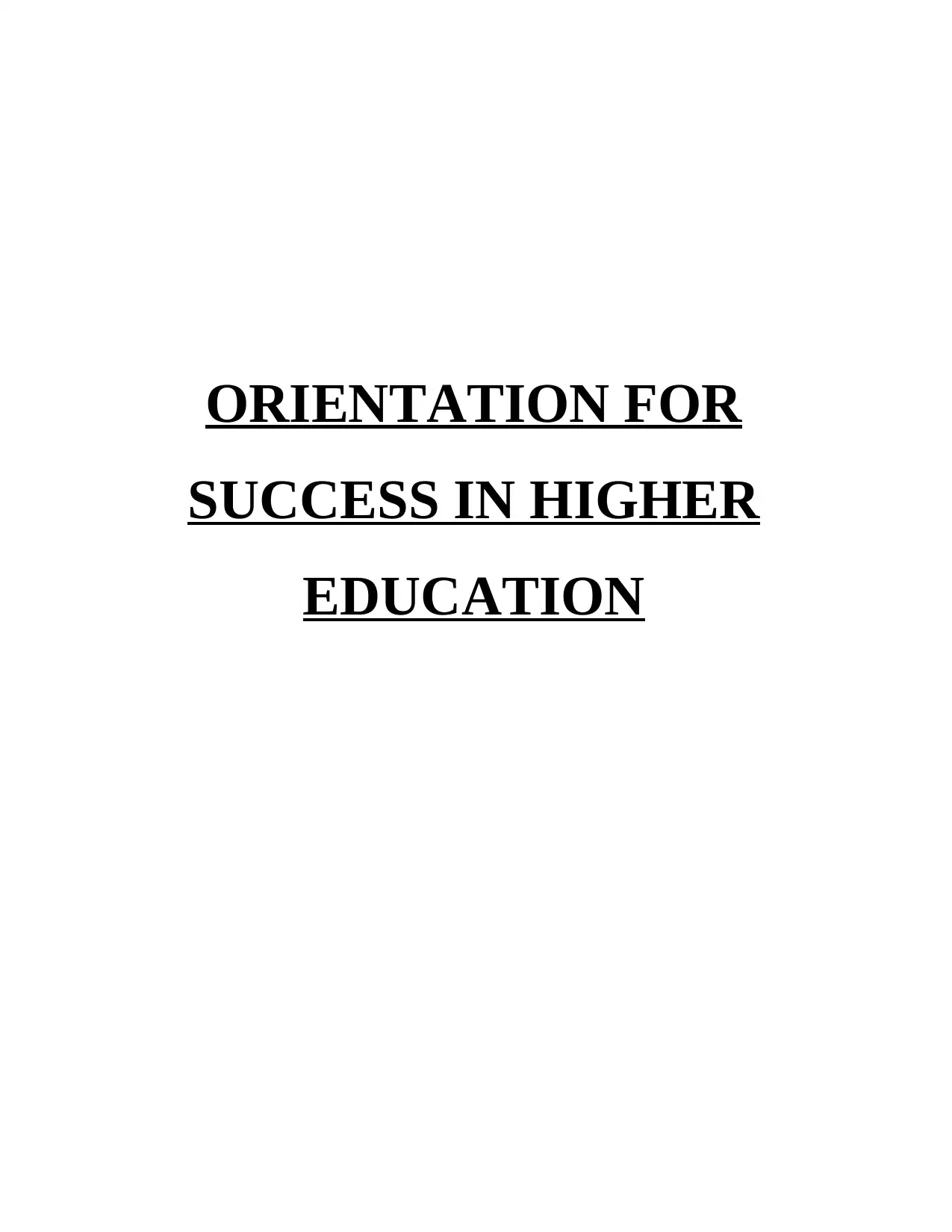
ORIENTATION FOR
SUCCESS IN HIGHER
EDUCATION
SUCCESS IN HIGHER
EDUCATION
Paraphrase This Document
Need a fresh take? Get an instant paraphrase of this document with our AI Paraphraser
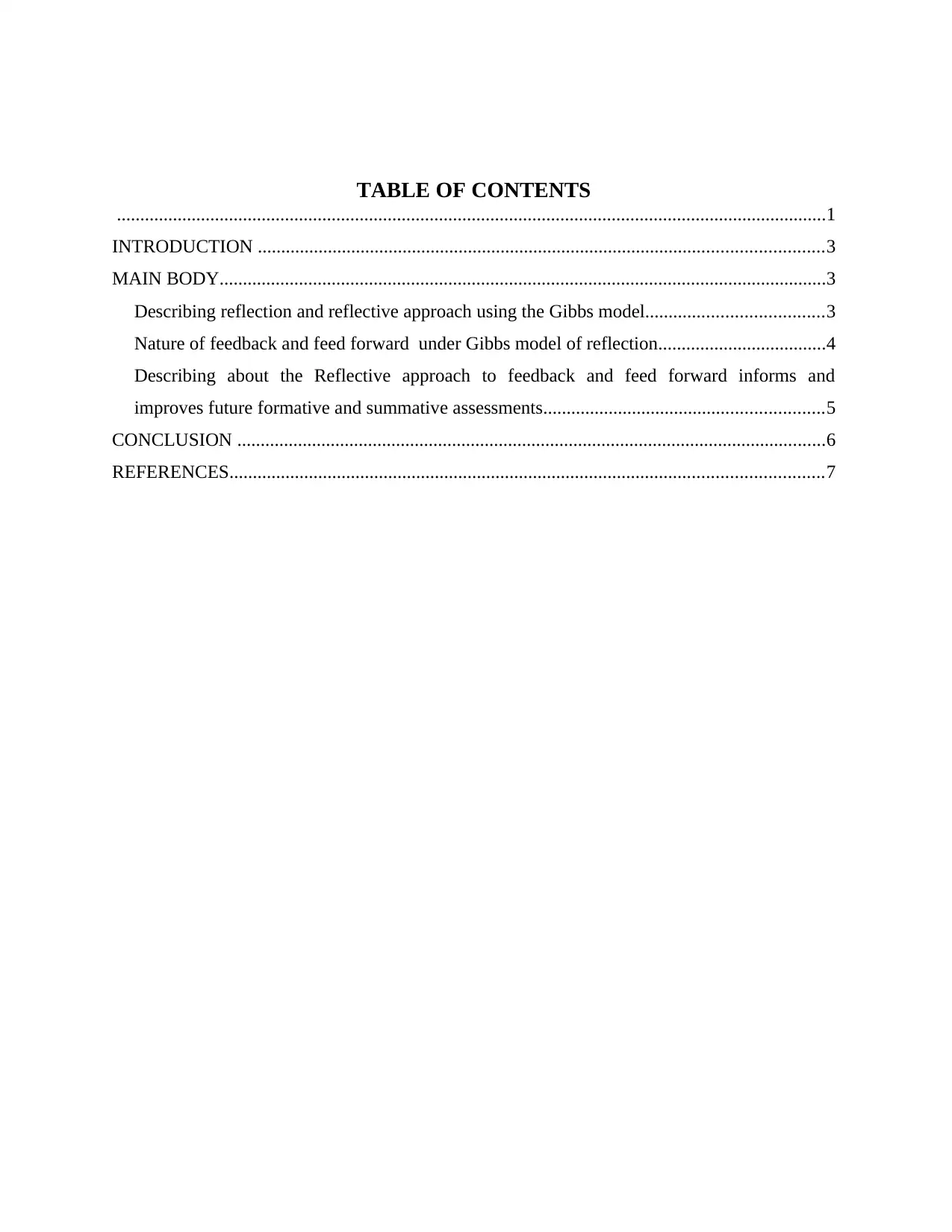
TABLE OF CONTENTS
........................................................................................................................................................1
INTRODUCTION .........................................................................................................................3
MAIN BODY..................................................................................................................................3
Describing reflection and reflective approach using the Gibbs model......................................3
Nature of feedback and feed forward under Gibbs model of reflection....................................4
Describing about the Reflective approach to feedback and feed forward informs and
improves future formative and summative assessments............................................................5
CONCLUSION ..............................................................................................................................6
REFERENCES...............................................................................................................................7
........................................................................................................................................................1
INTRODUCTION .........................................................................................................................3
MAIN BODY..................................................................................................................................3
Describing reflection and reflective approach using the Gibbs model......................................3
Nature of feedback and feed forward under Gibbs model of reflection....................................4
Describing about the Reflective approach to feedback and feed forward informs and
improves future formative and summative assessments............................................................5
CONCLUSION ..............................................................................................................................6
REFERENCES...............................................................................................................................7
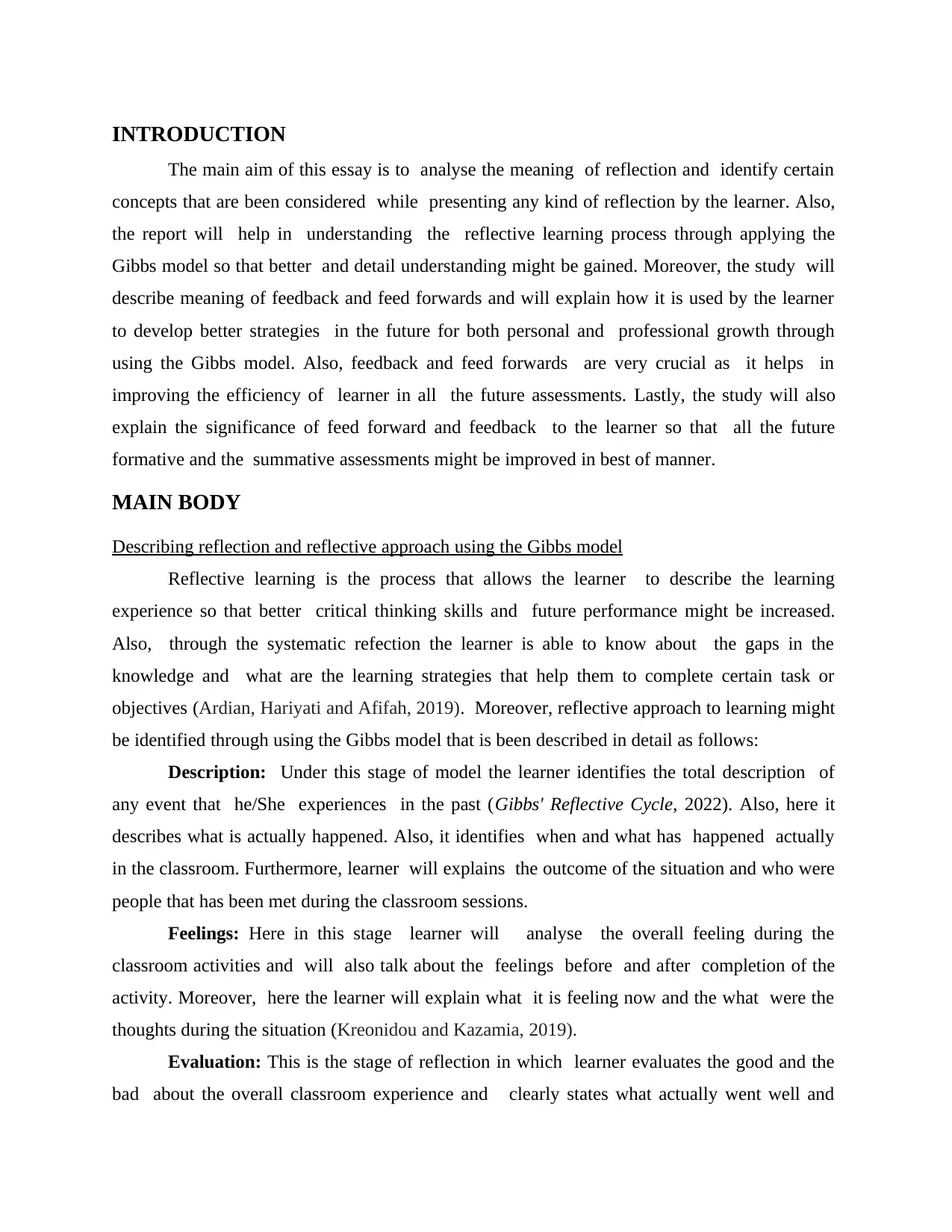
INTRODUCTION
The main aim of this essay is to analyse the meaning of reflection and identify certain
concepts that are been considered while presenting any kind of reflection by the learner. Also,
the report will help in understanding the reflective learning process through applying the
Gibbs model so that better and detail understanding might be gained. Moreover, the study will
describe meaning of feedback and feed forwards and will explain how it is used by the learner
to develop better strategies in the future for both personal and professional growth through
using the Gibbs model. Also, feedback and feed forwards are very crucial as it helps in
improving the efficiency of learner in all the future assessments. Lastly, the study will also
explain the significance of feed forward and feedback to the learner so that all the future
formative and the summative assessments might be improved in best of manner.
MAIN BODY
Describing reflection and reflective approach using the Gibbs model
Reflective learning is the process that allows the learner to describe the learning
experience so that better critical thinking skills and future performance might be increased.
Also, through the systematic refection the learner is able to know about the gaps in the
knowledge and what are the learning strategies that help them to complete certain task or
objectives (Ardian, Hariyati and Afifah, 2019). Moreover, reflective approach to learning might
be identified through using the Gibbs model that is been described in detail as follows:
Description: Under this stage of model the learner identifies the total description of
any event that he/She experiences in the past (Gibbs' Reflective Cycle, 2022). Also, here it
describes what is actually happened. Also, it identifies when and what has happened actually
in the classroom. Furthermore, learner will explains the outcome of the situation and who were
people that has been met during the classroom sessions.
Feelings: Here in this stage learner will analyse the overall feeling during the
classroom activities and will also talk about the feelings before and after completion of the
activity. Moreover, here the learner will explain what it is feeling now and the what were the
thoughts during the situation (Kreonidou and Kazamia, 2019).
Evaluation: This is the stage of reflection in which learner evaluates the good and the
bad about the overall classroom experience and clearly states what actually went well and
The main aim of this essay is to analyse the meaning of reflection and identify certain
concepts that are been considered while presenting any kind of reflection by the learner. Also,
the report will help in understanding the reflective learning process through applying the
Gibbs model so that better and detail understanding might be gained. Moreover, the study will
describe meaning of feedback and feed forwards and will explain how it is used by the learner
to develop better strategies in the future for both personal and professional growth through
using the Gibbs model. Also, feedback and feed forwards are very crucial as it helps in
improving the efficiency of learner in all the future assessments. Lastly, the study will also
explain the significance of feed forward and feedback to the learner so that all the future
formative and the summative assessments might be improved in best of manner.
MAIN BODY
Describing reflection and reflective approach using the Gibbs model
Reflective learning is the process that allows the learner to describe the learning
experience so that better critical thinking skills and future performance might be increased.
Also, through the systematic refection the learner is able to know about the gaps in the
knowledge and what are the learning strategies that help them to complete certain task or
objectives (Ardian, Hariyati and Afifah, 2019). Moreover, reflective approach to learning might
be identified through using the Gibbs model that is been described in detail as follows:
Description: Under this stage of model the learner identifies the total description of
any event that he/She experiences in the past (Gibbs' Reflective Cycle, 2022). Also, here it
describes what is actually happened. Also, it identifies when and what has happened actually
in the classroom. Furthermore, learner will explains the outcome of the situation and who were
people that has been met during the classroom sessions.
Feelings: Here in this stage learner will analyse the overall feeling during the
classroom activities and will also talk about the feelings before and after completion of the
activity. Moreover, here the learner will explain what it is feeling now and the what were the
thoughts during the situation (Kreonidou and Kazamia, 2019).
Evaluation: This is the stage of reflection in which learner evaluates the good and the
bad about the overall classroom experience and clearly states what actually went well and
You're viewing a preview
Unlock full access by subscribing today!
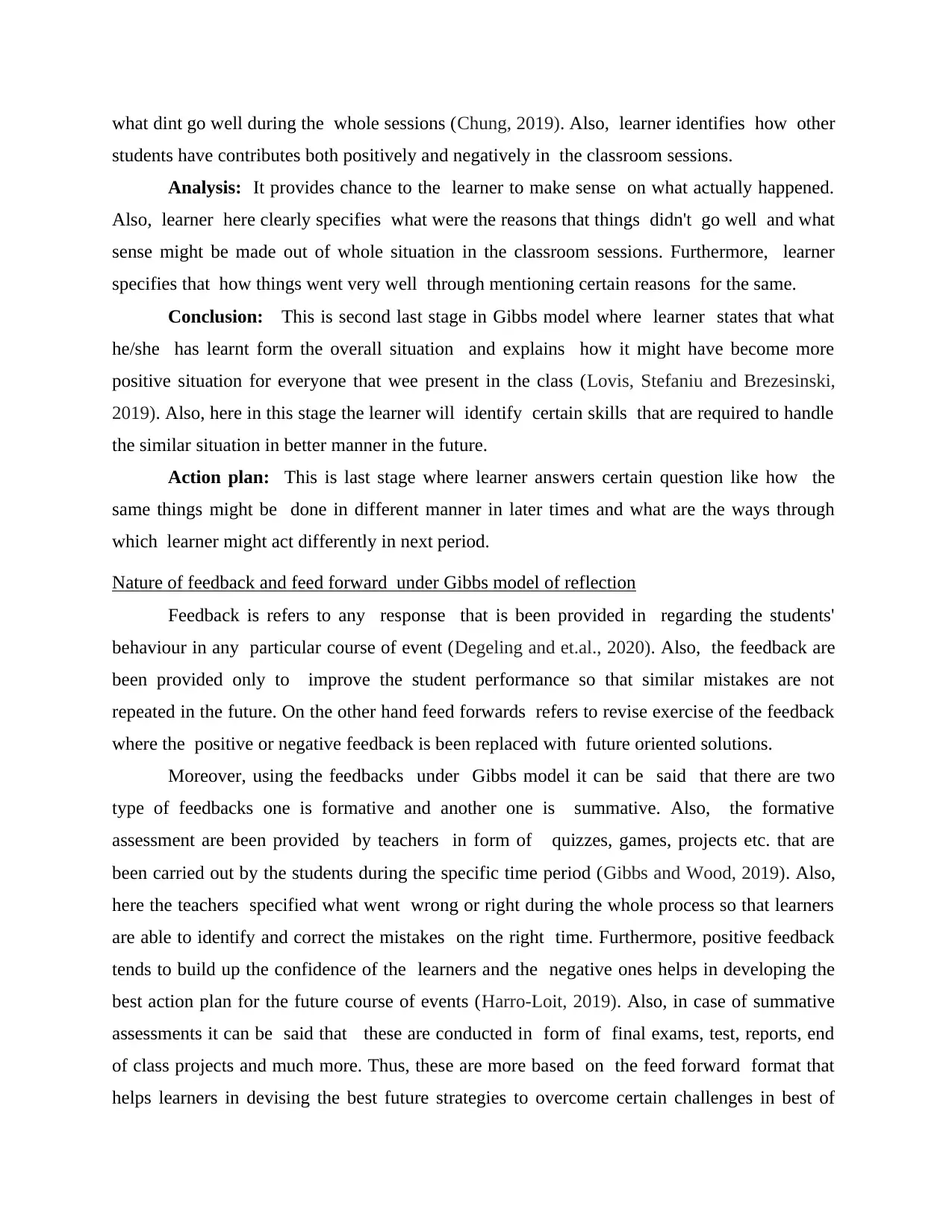
what dint go well during the whole sessions (Chung, 2019). Also, learner identifies how other
students have contributes both positively and negatively in the classroom sessions.
Analysis: It provides chance to the learner to make sense on what actually happened.
Also, learner here clearly specifies what were the reasons that things didn't go well and what
sense might be made out of whole situation in the classroom sessions. Furthermore, learner
specifies that how things went very well through mentioning certain reasons for the same.
Conclusion: This is second last stage in Gibbs model where learner states that what
he/she has learnt form the overall situation and explains how it might have become more
positive situation for everyone that wee present in the class (Lovis, Stefaniu and Brezesinski,
2019). Also, here in this stage the learner will identify certain skills that are required to handle
the similar situation in better manner in the future.
Action plan: This is last stage where learner answers certain question like how the
same things might be done in different manner in later times and what are the ways through
which learner might act differently in next period.
Nature of feedback and feed forward under Gibbs model of reflection
Feedback is refers to any response that is been provided in regarding the students'
behaviour in any particular course of event (Degeling and et.al., 2020). Also, the feedback are
been provided only to improve the student performance so that similar mistakes are not
repeated in the future. On the other hand feed forwards refers to revise exercise of the feedback
where the positive or negative feedback is been replaced with future oriented solutions.
Moreover, using the feedbacks under Gibbs model it can be said that there are two
type of feedbacks one is formative and another one is summative. Also, the formative
assessment are been provided by teachers in form of quizzes, games, projects etc. that are
been carried out by the students during the specific time period (Gibbs and Wood, 2019). Also,
here the teachers specified what went wrong or right during the whole process so that learners
are able to identify and correct the mistakes on the right time. Furthermore, positive feedback
tends to build up the confidence of the learners and the negative ones helps in developing the
best action plan for the future course of events (Harro-Loit, 2019). Also, in case of summative
assessments it can be said that these are conducted in form of final exams, test, reports, end
of class projects and much more. Thus, these are more based on the feed forward format that
helps learners in devising the best future strategies to overcome certain challenges in best of
students have contributes both positively and negatively in the classroom sessions.
Analysis: It provides chance to the learner to make sense on what actually happened.
Also, learner here clearly specifies what were the reasons that things didn't go well and what
sense might be made out of whole situation in the classroom sessions. Furthermore, learner
specifies that how things went very well through mentioning certain reasons for the same.
Conclusion: This is second last stage in Gibbs model where learner states that what
he/she has learnt form the overall situation and explains how it might have become more
positive situation for everyone that wee present in the class (Lovis, Stefaniu and Brezesinski,
2019). Also, here in this stage the learner will identify certain skills that are required to handle
the similar situation in better manner in the future.
Action plan: This is last stage where learner answers certain question like how the
same things might be done in different manner in later times and what are the ways through
which learner might act differently in next period.
Nature of feedback and feed forward under Gibbs model of reflection
Feedback is refers to any response that is been provided in regarding the students'
behaviour in any particular course of event (Degeling and et.al., 2020). Also, the feedback are
been provided only to improve the student performance so that similar mistakes are not
repeated in the future. On the other hand feed forwards refers to revise exercise of the feedback
where the positive or negative feedback is been replaced with future oriented solutions.
Moreover, using the feedbacks under Gibbs model it can be said that there are two
type of feedbacks one is formative and another one is summative. Also, the formative
assessment are been provided by teachers in form of quizzes, games, projects etc. that are
been carried out by the students during the specific time period (Gibbs and Wood, 2019). Also,
here the teachers specified what went wrong or right during the whole process so that learners
are able to identify and correct the mistakes on the right time. Furthermore, positive feedback
tends to build up the confidence of the learners and the negative ones helps in developing the
best action plan for the future course of events (Harro-Loit, 2019). Also, in case of summative
assessments it can be said that these are conducted in form of final exams, test, reports, end
of class projects and much more. Thus, these are more based on the feed forward format that
helps learners in devising the best future strategies to overcome certain challenges in best of
Paraphrase This Document
Need a fresh take? Get an instant paraphrase of this document with our AI Paraphraser
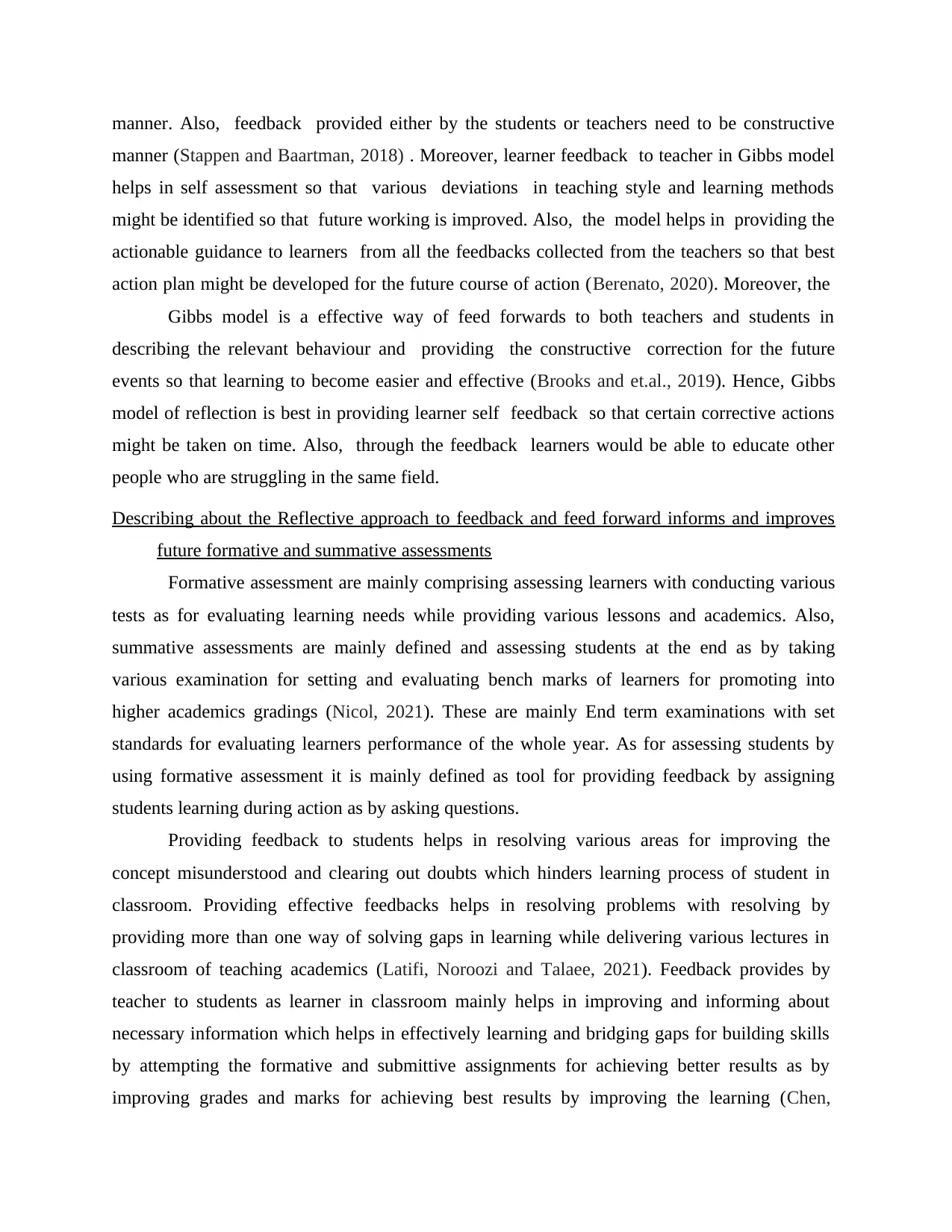
manner. Also, feedback provided either by the students or teachers need to be constructive
manner (Stappen and Baartman, 2018) . Moreover, learner feedback to teacher in Gibbs model
helps in self assessment so that various deviations in teaching style and learning methods
might be identified so that future working is improved. Also, the model helps in providing the
actionable guidance to learners from all the feedbacks collected from the teachers so that best
action plan might be developed for the future course of action (Berenato, 2020). Moreover, the
Gibbs model is a effective way of feed forwards to both teachers and students in
describing the relevant behaviour and providing the constructive correction for the future
events so that learning to become easier and effective (Brooks and et.al., 2019). Hence, Gibbs
model of reflection is best in providing learner self feedback so that certain corrective actions
might be taken on time. Also, through the feedback learners would be able to educate other
people who are struggling in the same field.
Describing about the Reflective approach to feedback and feed forward informs and improves
future formative and summative assessments
Formative assessment are mainly comprising assessing learners with conducting various
tests as for evaluating learning needs while providing various lessons and academics. Also,
summative assessments are mainly defined and assessing students at the end as by taking
various examination for setting and evaluating bench marks of learners for promoting into
higher academics gradings (Nicol, 2021). These are mainly End term examinations with set
standards for evaluating learners performance of the whole year. As for assessing students by
using formative assessment it is mainly defined as tool for providing feedback by assigning
students learning during action as by asking questions.
Providing feedback to students helps in resolving various areas for improving the
concept misunderstood and clearing out doubts which hinders learning process of student in
classroom. Providing effective feedbacks helps in resolving problems with resolving by
providing more than one way of solving gaps in learning while delivering various lectures in
classroom of teaching academics (Latifi, Noroozi and Talaee, 2021). Feedback provides by
teacher to students as learner in classroom mainly helps in improving and informing about
necessary information which helps in effectively learning and bridging gaps for building skills
by attempting the formative and submittive assignments for achieving better results as by
improving grades and marks for achieving best results by improving the learning (Chen,
manner (Stappen and Baartman, 2018) . Moreover, learner feedback to teacher in Gibbs model
helps in self assessment so that various deviations in teaching style and learning methods
might be identified so that future working is improved. Also, the model helps in providing the
actionable guidance to learners from all the feedbacks collected from the teachers so that best
action plan might be developed for the future course of action (Berenato, 2020). Moreover, the
Gibbs model is a effective way of feed forwards to both teachers and students in
describing the relevant behaviour and providing the constructive correction for the future
events so that learning to become easier and effective (Brooks and et.al., 2019). Hence, Gibbs
model of reflection is best in providing learner self feedback so that certain corrective actions
might be taken on time. Also, through the feedback learners would be able to educate other
people who are struggling in the same field.
Describing about the Reflective approach to feedback and feed forward informs and improves
future formative and summative assessments
Formative assessment are mainly comprising assessing learners with conducting various
tests as for evaluating learning needs while providing various lessons and academics. Also,
summative assessments are mainly defined and assessing students at the end as by taking
various examination for setting and evaluating bench marks of learners for promoting into
higher academics gradings (Nicol, 2021). These are mainly End term examinations with set
standards for evaluating learners performance of the whole year. As for assessing students by
using formative assessment it is mainly defined as tool for providing feedback by assigning
students learning during action as by asking questions.
Providing feedback to students helps in resolving various areas for improving the
concept misunderstood and clearing out doubts which hinders learning process of student in
classroom. Providing effective feedbacks helps in resolving problems with resolving by
providing more than one way of solving gaps in learning while delivering various lectures in
classroom of teaching academics (Latifi, Noroozi and Talaee, 2021). Feedback provides by
teacher to students as learner in classroom mainly helps in improving and informing about
necessary information which helps in effectively learning and bridging gaps for building skills
by attempting the formative and submittive assignments for achieving better results as by
improving grades and marks for achieving best results by improving the learning (Chen,
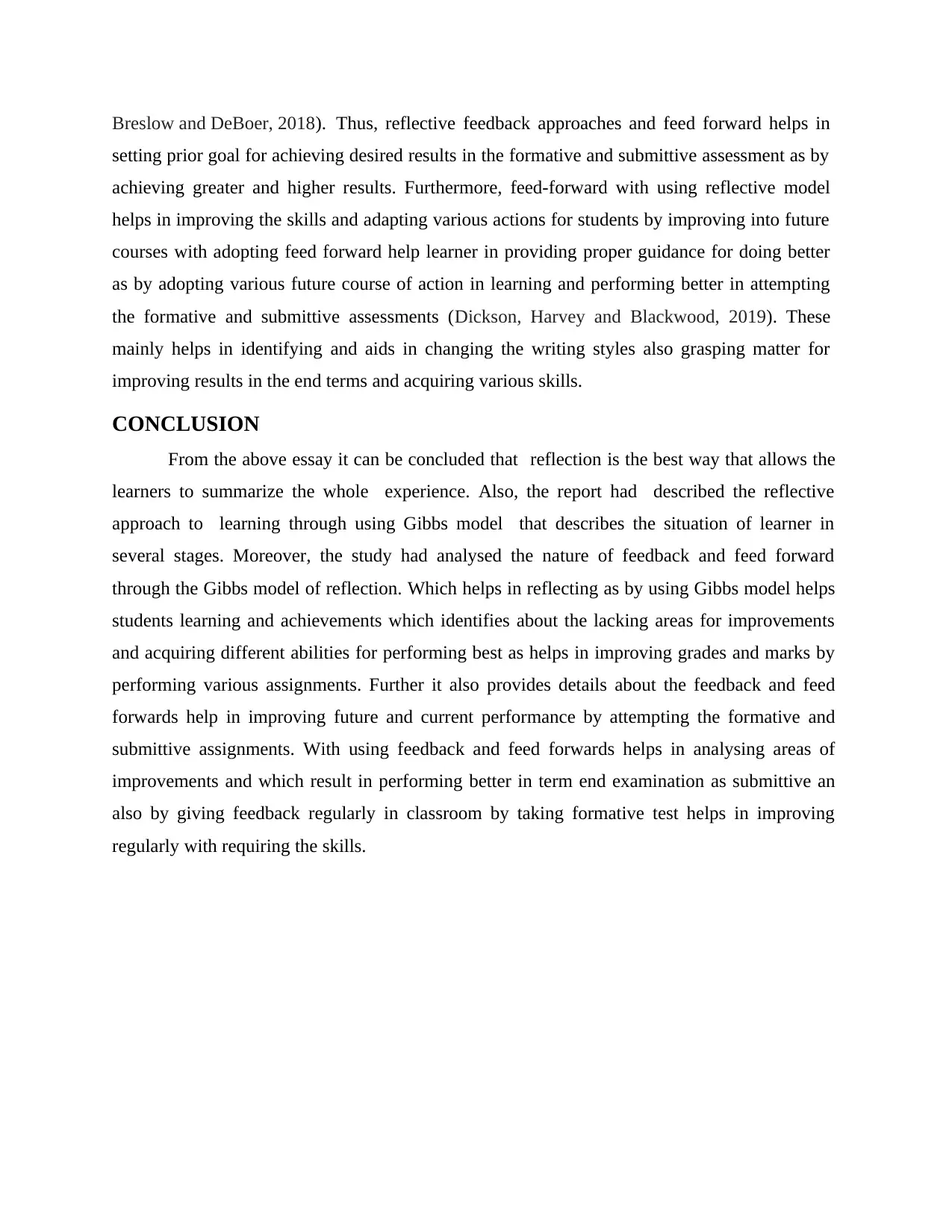
Breslow and DeBoer, 2018). Thus, reflective feedback approaches and feed forward helps in
setting prior goal for achieving desired results in the formative and submittive assessment as by
achieving greater and higher results. Furthermore, feed-forward with using reflective model
helps in improving the skills and adapting various actions for students by improving into future
courses with adopting feed forward help learner in providing proper guidance for doing better
as by adopting various future course of action in learning and performing better in attempting
the formative and submittive assessments (Dickson, Harvey and Blackwood, 2019). These
mainly helps in identifying and aids in changing the writing styles also grasping matter for
improving results in the end terms and acquiring various skills.
CONCLUSION
From the above essay it can be concluded that reflection is the best way that allows the
learners to summarize the whole experience. Also, the report had described the reflective
approach to learning through using Gibbs model that describes the situation of learner in
several stages. Moreover, the study had analysed the nature of feedback and feed forward
through the Gibbs model of reflection. Which helps in reflecting as by using Gibbs model helps
students learning and achievements which identifies about the lacking areas for improvements
and acquiring different abilities for performing best as helps in improving grades and marks by
performing various assignments. Further it also provides details about the feedback and feed
forwards help in improving future and current performance by attempting the formative and
submittive assignments. With using feedback and feed forwards helps in analysing areas of
improvements and which result in performing better in term end examination as submittive an
also by giving feedback regularly in classroom by taking formative test helps in improving
regularly with requiring the skills.
setting prior goal for achieving desired results in the formative and submittive assessment as by
achieving greater and higher results. Furthermore, feed-forward with using reflective model
helps in improving the skills and adapting various actions for students by improving into future
courses with adopting feed forward help learner in providing proper guidance for doing better
as by adopting various future course of action in learning and performing better in attempting
the formative and submittive assessments (Dickson, Harvey and Blackwood, 2019). These
mainly helps in identifying and aids in changing the writing styles also grasping matter for
improving results in the end terms and acquiring various skills.
CONCLUSION
From the above essay it can be concluded that reflection is the best way that allows the
learners to summarize the whole experience. Also, the report had described the reflective
approach to learning through using Gibbs model that describes the situation of learner in
several stages. Moreover, the study had analysed the nature of feedback and feed forward
through the Gibbs model of reflection. Which helps in reflecting as by using Gibbs model helps
students learning and achievements which identifies about the lacking areas for improvements
and acquiring different abilities for performing best as helps in improving grades and marks by
performing various assignments. Further it also provides details about the feedback and feed
forwards help in improving future and current performance by attempting the formative and
submittive assignments. With using feedback and feed forwards helps in analysing areas of
improvements and which result in performing better in term end examination as submittive an
also by giving feedback regularly in classroom by taking formative test helps in improving
regularly with requiring the skills.
You're viewing a preview
Unlock full access by subscribing today!
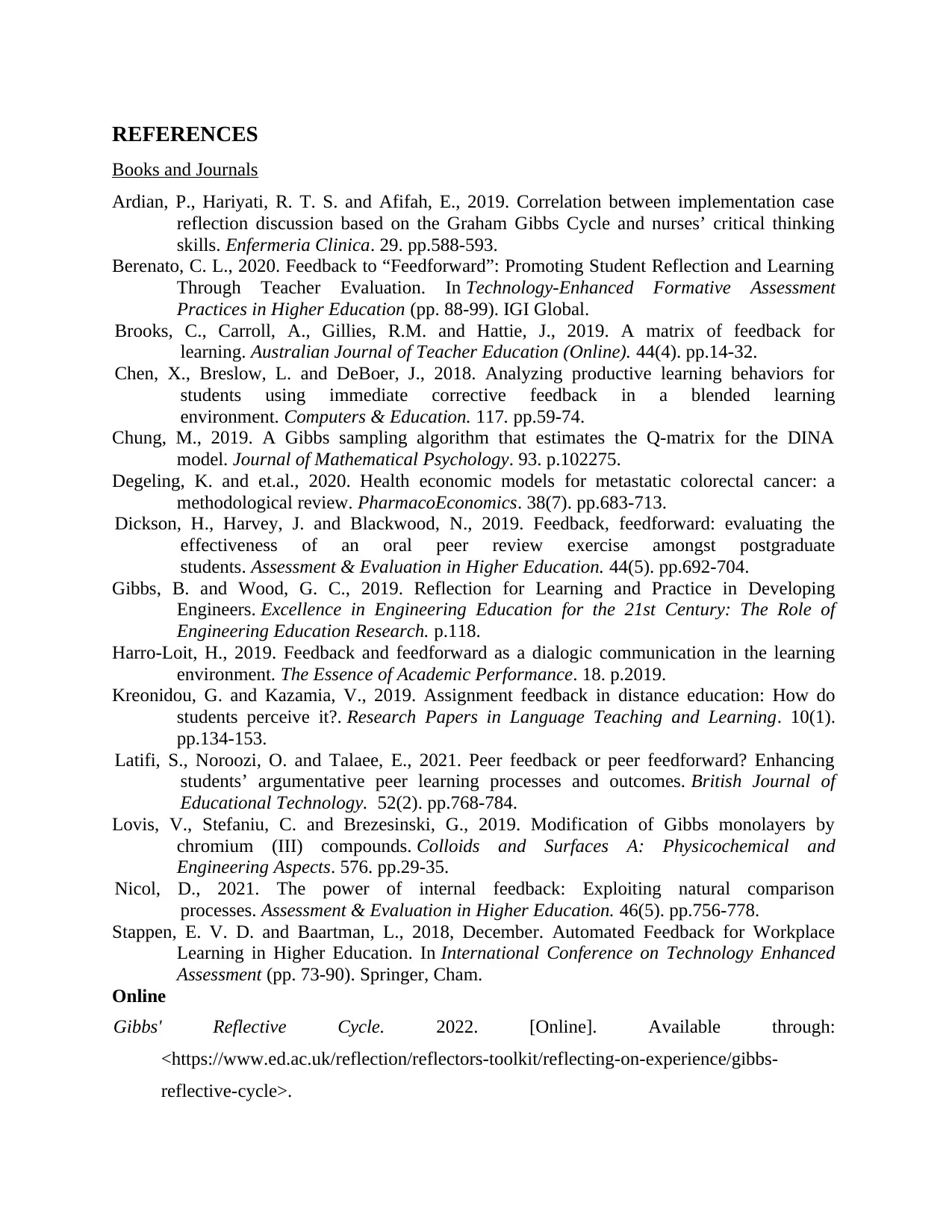
REFERENCES
Books and Journals
Ardian, P., Hariyati, R. T. S. and Afifah, E., 2019. Correlation between implementation case
reflection discussion based on the Graham Gibbs Cycle and nurses’ critical thinking
skills. Enfermeria Clinica. 29. pp.588-593.
Berenato, C. L., 2020. Feedback to “Feedforward”: Promoting Student Reflection and Learning
Through Teacher Evaluation. In Technology-Enhanced Formative Assessment
Practices in Higher Education (pp. 88-99). IGI Global.
Brooks, C., Carroll, A., Gillies, R.M. and Hattie, J., 2019. A matrix of feedback for
learning. Australian Journal of Teacher Education (Online). 44(4). pp.14-32.
Chen, X., Breslow, L. and DeBoer, J., 2018. Analyzing productive learning behaviors for
students using immediate corrective feedback in a blended learning
environment. Computers & Education. 117. pp.59-74.
Chung, M., 2019. A Gibbs sampling algorithm that estimates the Q-matrix for the DINA
model. Journal of Mathematical Psychology. 93. p.102275.
Degeling, K. and et.al., 2020. Health economic models for metastatic colorectal cancer: a
methodological review. PharmacoEconomics. 38(7). pp.683-713.
Dickson, H., Harvey, J. and Blackwood, N., 2019. Feedback, feedforward: evaluating the
effectiveness of an oral peer review exercise amongst postgraduate
students. Assessment & Evaluation in Higher Education. 44(5). pp.692-704.
Gibbs, B. and Wood, G. C., 2019. Reflection for Learning and Practice in Developing
Engineers. Excellence in Engineering Education for the 21st Century: The Role of
Engineering Education Research. p.118.
Harro-Loit, H., 2019. Feedback and feedforward as a dialogic communication in the learning
environment. The Essence of Academic Performance. 18. p.2019.
Kreonidou, G. and Kazamia, V., 2019. Assignment feedback in distance education: How do
students perceive it?. Research Papers in Language Teaching and Learning. 10(1).
pp.134-153.
Latifi, S., Noroozi, O. and Talaee, E., 2021. Peer feedback or peer feedforward? Enhancing
students’ argumentative peer learning processes and outcomes. British Journal of
Educational Technology. 52(2). pp.768-784.
Lovis, V., Stefaniu, C. and Brezesinski, G., 2019. Modification of Gibbs monolayers by
chromium (III) compounds. Colloids and Surfaces A: Physicochemical and
Engineering Aspects. 576. pp.29-35.
Nicol, D., 2021. The power of internal feedback: Exploiting natural comparison
processes. Assessment & Evaluation in Higher Education. 46(5). pp.756-778.
Stappen, E. V. D. and Baartman, L., 2018, December. Automated Feedback for Workplace
Learning in Higher Education. In International Conference on Technology Enhanced
Assessment (pp. 73-90). Springer, Cham.
Online
Gibbs' Reflective Cycle. 2022. [Online]. Available through:
<https://www.ed.ac.uk/reflection/reflectors-toolkit/reflecting-on-experience/gibbs-
reflective-cycle>.
Books and Journals
Ardian, P., Hariyati, R. T. S. and Afifah, E., 2019. Correlation between implementation case
reflection discussion based on the Graham Gibbs Cycle and nurses’ critical thinking
skills. Enfermeria Clinica. 29. pp.588-593.
Berenato, C. L., 2020. Feedback to “Feedforward”: Promoting Student Reflection and Learning
Through Teacher Evaluation. In Technology-Enhanced Formative Assessment
Practices in Higher Education (pp. 88-99). IGI Global.
Brooks, C., Carroll, A., Gillies, R.M. and Hattie, J., 2019. A matrix of feedback for
learning. Australian Journal of Teacher Education (Online). 44(4). pp.14-32.
Chen, X., Breslow, L. and DeBoer, J., 2018. Analyzing productive learning behaviors for
students using immediate corrective feedback in a blended learning
environment. Computers & Education. 117. pp.59-74.
Chung, M., 2019. A Gibbs sampling algorithm that estimates the Q-matrix for the DINA
model. Journal of Mathematical Psychology. 93. p.102275.
Degeling, K. and et.al., 2020. Health economic models for metastatic colorectal cancer: a
methodological review. PharmacoEconomics. 38(7). pp.683-713.
Dickson, H., Harvey, J. and Blackwood, N., 2019. Feedback, feedforward: evaluating the
effectiveness of an oral peer review exercise amongst postgraduate
students. Assessment & Evaluation in Higher Education. 44(5). pp.692-704.
Gibbs, B. and Wood, G. C., 2019. Reflection for Learning and Practice in Developing
Engineers. Excellence in Engineering Education for the 21st Century: The Role of
Engineering Education Research. p.118.
Harro-Loit, H., 2019. Feedback and feedforward as a dialogic communication in the learning
environment. The Essence of Academic Performance. 18. p.2019.
Kreonidou, G. and Kazamia, V., 2019. Assignment feedback in distance education: How do
students perceive it?. Research Papers in Language Teaching and Learning. 10(1).
pp.134-153.
Latifi, S., Noroozi, O. and Talaee, E., 2021. Peer feedback or peer feedforward? Enhancing
students’ argumentative peer learning processes and outcomes. British Journal of
Educational Technology. 52(2). pp.768-784.
Lovis, V., Stefaniu, C. and Brezesinski, G., 2019. Modification of Gibbs monolayers by
chromium (III) compounds. Colloids and Surfaces A: Physicochemical and
Engineering Aspects. 576. pp.29-35.
Nicol, D., 2021. The power of internal feedback: Exploiting natural comparison
processes. Assessment & Evaluation in Higher Education. 46(5). pp.756-778.
Stappen, E. V. D. and Baartman, L., 2018, December. Automated Feedback for Workplace
Learning in Higher Education. In International Conference on Technology Enhanced
Assessment (pp. 73-90). Springer, Cham.
Online
Gibbs' Reflective Cycle. 2022. [Online]. Available through:
<https://www.ed.ac.uk/reflection/reflectors-toolkit/reflecting-on-experience/gibbs-
reflective-cycle>.
Paraphrase This Document
Need a fresh take? Get an instant paraphrase of this document with our AI Paraphraser

1 out of 8
Related Documents
Your All-in-One AI-Powered Toolkit for Academic Success.
+13062052269
info@desklib.com
Available 24*7 on WhatsApp / Email
![[object Object]](/_next/static/media/star-bottom.7253800d.svg)
Unlock your academic potential
© 2024 | Zucol Services PVT LTD | All rights reserved.




